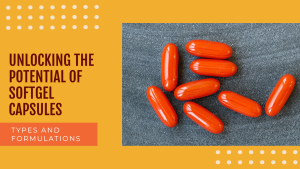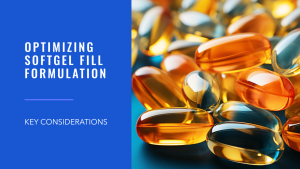The Ultimate Guide to Soft Gelatin Capsule Manufacturing

Producing soft gelatin capsules (softgels) involves meticulous attention to detail and a deep understanding of the materials and processes. In this article, we will delve into the critical aspects of fill material production, exploring techniques to ensure uniformity, the importance of equipment, and common challenges faced during manufacturing. Our goal is to provide insights that help enhance the quality and consistency of softgels, ensuring they meet regulatory standards and consumer expectations.
Fill Material Production
The cornerstone of effective softgel manufacturing is ensuring that all ingredients are fully dissolved or uniformly mixed. For formulations where the liquid is a suspension, continuous mixing up to the point of encapsulation is vital to maintain uniform dispersion of the fill and active materials. This process may require additional heating, cooling, and mixing to achieve the desired consistency. Ingredients such as minerals, vitamins, and oils often must be added at different stages depending on their heat sensitivity.
Once the mixing process is complete, the batch can be temporarily stored or transferred to the encapsulation machine. The ultimate goal is to achieve complete uniformity in the fill material, which requires careful consideration of the methods and tools used in the process.
Handling Medium or Heavy Paste Mixtures
It is essential to maintain uniformity (to prevent the settling of the powders) of the filling mixture within the holding tank after the creation of the fill material. This is especially important when the tank is connected to the encapsulation machine. This process is accomplished by using either:
- With a mixing paddle, manually mix the tank solution carefully every 30 minutes, not introducing air.
- An in-tank mixing blade (e.g., Lightnin mixer) on slow speed.
Equipment
The right equipment is essential for ensuring the quality and consistency of the fill material. Critical pieces of equipment include:
- Stainless Steel Fill Tanks: Equipped with lids, bottom ball valves, and wheels for mobility, some of these tanks also have heating capabilities.
- Bulk Tanks: Made from coated steel, stainless steel, or plastic, these are used for large-volume oil production where minimal air exposure is required.
- High-Shear Mixers: These blend powders and suspending materials and are often equipped with heating, vacuum, and homogenizer mixing heads.
- Milling Equipment: Includes stone mills, colloid mills, ball mills, and roller mills for particle size reduction.
- Transfer Pumps and Mixers: Lightnin or drum mixers for efficient material handling.
- Drum Heaters and Hot Plates: Used for melting waxes like beeswax.
- Mesh Screens and Sieves: Remove large particles and ensure uniform powder size.
- Nitrogen Gas: Used to blanket oxygen-sensitive materials, preventing their degradation.

The Blending and Mixing Process
Oils
Oil formulations are often straightforward, as the ingredients are mixed in a stainless steel tank. Examples include Vitamin E, fish oils, evening primrose oil, and flaxseed oil. However, inspecting the oil for quality issues (particles, color) before transferring it from the drum to a mobile tank is essential.
Tips:
- Use mechanical and electric mixers to save time and ensure uniform products.
- Stirring should be smooth and fast enough to avoid foaming or adding air.
- Mixing under a vacuum helps remove trapped air, preventing air bubbles in the finished softgel.
- Surfactant-type fills like Krill oil, lecithin, or phosphatidylcholine are challenging to encapsulate.
- Tank temperatures: 25°- 40° C (Temps will vary depending on the mixture model).
Solutions
Creating a uniform mixture is critical when dealing with solutions. Filtering the liquid helps obtain a straightforward product, and dissolving the active compound in a minimal quantity of solvent before adding the vehicle ensures even distribution.
Tips:
- Stirring should be continuous and smooth to avoid foaming.
- Add high-viscosity liquids to low-viscosity liquids with constant stirring.
- Mix under a vacuum to remove trapped air, or apply a vacuum at the end of the mixing cycle.
- Heat as needed, generally not exceeding 35°- 40°C.
- Tank temperatures: 25°- 40°C, varying by mixture.
Suspensions
The particle size is critical for suspensions. Powders should ideally be 80 mesh, and grinding or milling may be required to achieve the desired size. The mixing process involves dispersing powders into the vehicle phase and ensuring complete dispersion through continuous mixing.
Tips:
- Use surfactants to wet hydrophobic powders before adding them to the carrier.
- Incorporate insoluble materials by levigating the mixture with a small amount of vehicle.
- Ensure proper mixing equipment and steps, such as high-shear mixers and homogenizers.
- Mills: Jet mills or pin mills are preferred for handling various materials.
Emulsions
Creating stable emulsions requires carefully dissolving oil-soluble and water-soluble ingredients in their respective phases before combining them under constant agitation. Homogenization increases emulsion uniformity by reducing the size of fat and oil particles.
Tips:
- Heat the aqueous phase slightly warmer than the oil phase.
- Degassing water can improve its mixing ability with oil, enhancing emulsion stability.
- You can use the appropriate mixing equipment to achieve the desired emulsion quality.
Common Problems with blending
- Air in the Fill To prevent bubbles in the softgel, removing or avoiding air during blending is essential. Slow-speed mixing and vacuum application can help achieve this.
- Phase Separation Different oils may separate after storage, causing cosmetic or potency issues. Continuous mixing before and during encapsulation can help prevent this.
- Degradation of Powders: Large particle sizes can cause softgels to leak. Powders should be milled to 100% through 80 mesh to ensure small particle size.
- Fill Material Temperature: Maintaining the correct temperature (20°- 40°C) is crucial to prevent phase separation and ensure proper blending.
- Hygroscopicity: Some materials may interact and cause physical changes or pH issues. Laboratory testing is necessary to address formulation issues.
- Oxidation: Oil oxidation can degrade the quality of the fill material. Using nitrogen gas to blanket sensitive oils can prevent oxidation.
- Fill Material Thickness: Thick materials may not pump through the encapsulation machine. Proper blending, milling, and viscosity checks are essential to address this issue.
Real-World Applications
Implementing these best practices and addressing common challenges can significantly improve the quality and consistency of soft gelatin capsules. Manufacturers should continuously monitor and optimize their processes to ensure product excellence. By doing so, they can produce high-quality softgels that meet regulatory standards and consumer expectations.
Expert Insights
Developing a successful soft gelatin capsule manufacturer process requires collaboration between formulation scientists, quality assurance experts, and manufacturing engineers.
Vitor Antraco says, ” Always ensure your powders are milled to the correct size before use. Large particles can lead to leaking softgels and inconsistencies in the final product.”
Sair Torregrosa adds, “When working with thick fill materials, checking the viscosity in the lab before production can prevent issues during encapsulation. It’s about being proactive and catching potential problems before they affect the entire batch.”
Conclusion
The manufacturing process for soft gelatin capsule fill material requires meticulous attention. By following best practices and using the appropriate equipment, manufacturers can produce high-quality softgels that meet regulatory standards and consumer expectations. Continuous monitoring and optimization of the process are essential to maintaining product excellence.
Read the original text here
Source: Vitor Jacó Antraco and Sair Torregrosa, LinkedIn (68) The Ultimate Guide to Soft Gelatin Capsule Manufacturing | LinkedIn
See the full article series:

- Optimizing Softgel Fill Formulation: Key Considerations
- Coming soon: Gelatin Shell Material and Formulations for Softgels: An In-Depth Guide
- Coming soon: The Art Of Soft Gelatin Capsule Shells: A Look Into The Manufacturing Process


